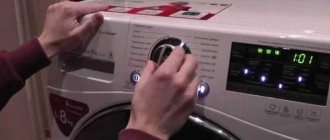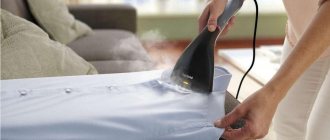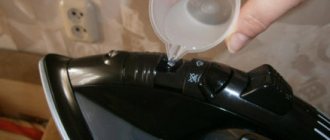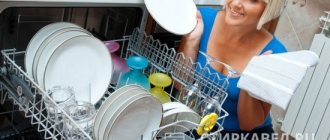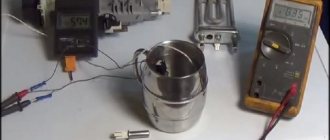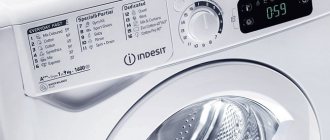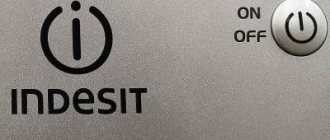In the modern world, women do not spend as much effort and hours on housework as before. This can be explained quite simply: having household appliances has helped simplify life.
It is enough to load the washing machine, set the required mode and wait for the working process to complete. This will help free up several hours to do other things: cleaning the apartment, preparing dinner or relaxing.
To choose the right washing technique, you must be guided by the following indicators:
- method of loading laundry;
- dimensions;
- functionality;
- spaciousness.
A well-chosen machine will be an excellent helper for a woman and the whole family.
Interesting reading: “How to choose a washing machine.”
Device design
Any washing machine consists of the following components:
- Frame. Protects internal equipment elements from damage.
- Drum. A moving part that allows the laundry to rotate during washing.
- Engine. The main force that rotates the drum.
- Tank. A container into which laundry is loaded.
- Pumps. Devices for filling the tank with water and removing excess moisture at the end of washing.
- Power block. Provides energy to the engine and electronic components of the system.
- Electronics. This includes the main control unit, sensors and switches for setting the operating mode of the machine.
General information
The first machine for washing clothes was described in 1752 under the name "Yorkshire Maid". It consisted of a wooden tank that could be closed with a lid and filled with laundry and hot soapy water. In the center of the lid was a wooden block with a handle at the top for turning, and at the bottom there was a wooden disk with recessed wooden pins that moved the laundry in the soapy water, turning back and forth. The size of this machine and its manual operation made it suitable for small households.
Water supply
Water is supplied to the washing machine through special hoses connected to the water supply in the apartment. How long it takes to fill the tank depends on the equipment parameters. The system can be set to a certain level for washing.
The design also includes pressure monitors, which are small sealed containers with membranes at the inlet. As soon as the desired water level is reached, the pressure inside the container increases. The contact system allows you to close the valve, thereby stopping the flow.
Some machines use pressure sensors in the form of special electronic controllers created using semiconductor technology. In this case, increasing water level with increasing pressure changes the electrical conductive characteristics of the device. The received signal is sent to the control board.
The regulators protect the system from flooding, prevent the heating element from running dry, and also act as foam detectors.
Sorting clothes
Proper sorting of clothes is not only the key to high-quality washing, but also a condition for reducing the risk of spoiling things in the process. Before putting dirty laundry into the washing machine drum, you should disassemble it according to the following rules:
- sorting by color. This is a simple rule known to everyone. White should be set aside separately from color, even if you plan to use a program with a low temperature. It is best to group colored items according to the degree of brightness and color saturation so that they do not fade. In addition, white and colored items even require different detergents, which once again emphasizes the need to separate them;
Sorting by color is a basic rule in washing; whites are washed separately, and colored items are separated according to the degree of shade saturation.
It is worth remembering that some items cannot be washed in a washing machine at all:
- wardrobe items and interior textiles, the label of which indicates that automatic washing is prohibited;
- things with a lot of mass. Even if you manage to stuff a large cotton blanket into the drum and its dry weight does not exceed the limit, then if it gets wet, the excess weight will lead to an error in the operation of the machine, or in the worst case, to its breakdown;
- things with large metal elements, rough fittings that can damage the drum;
- Leather Products;
- clothes contaminated with fuel oil, gasoline, bitumen, etc. Oily products can ruin other things in the drum, and in addition harm the washing machine itself (due to the negative effect of such substances on rubber and plastic parts).
Water heating
As soon as the tank of the machine is filled, a special control board activates the heating element, represented by a traditional tubular heating element system. The element increases the temperature of the water until the thermistor signals that heating has stopped.
Thus, three devices are involved in the process of heating water: a control board, a thermistor and a heating element. If at least one of the elements stops working correctly, errors will occur. The water may remain cold for the entire wash cycle or, on the contrary, heat up to very high temperatures or even boil.
How to choose?
Since the majority of modern steam ovens are expensive devices, they must be selected especially responsibly so as not to later regret the money spent. Let's figure out how to choose these useful devices correctly.
- Functional. Steam ovens vary in functionality. Different models are capable of solving different problems. Before going to the store, you should study the features of the models and decide which configurations will be useful to you, and for which there is no point in overpaying. This way you can save money.
- Dimensions. Before you buy a steam oven, allocate some space for it, clear it and measure it. Most modern devices do not have the largest dimensions, so you can find a suitable product on sale for a very small room.
- Design. The design of steam cabinets is usually thoughtful and very attractive. Professional designers work on the products of many brands, thanks to whom real technical “works of art” are released that can enrich and decorate the interior. Choose equipment that will harmoniously fit into the environment that you have allocated for it. You can find devices of different colors on sale - find a copy you like that will not stand out from the interior.
- Build quality. Before paying, carefully inspect the steam oven model you want to buy. Be as careful as possible when doing this. The structure must be assembled perfectly; there should be no loose elements, creaky or loose parts. The body of the product itself must be in perfect condition - there should be no scratches, abrasions, or any other possible damage.
- This expensive item, produced exclusively by well-known brands, should be purchased only in trusted stores that sell original household appliances. Usually this is where the largest assortment of manufactured models is present, and if the required copy is not available for sale, it can be ordered.
Washing process
After loading the laundry into the inside of the washing machine, you need to close the hatch, and then select the desired washing program using the buttons and controls. As soon as the user starts the machine, the machine will lock the hatch and start washing.
Washing steps briefly:
- Engine starting. The motor speed is adjusted using a built-in tachometer. Detergent is placed from the powder container into the main chamber of the machine. At the same moment, the tank is filled with cold water, the volume of which is determined by the selected washing program. This stage involves soaking the laundry.
- Turning on the heating element. The heating of this element is also adjusted using a special sensor. The washing parameters are selected automatically after the user has selected the desired mode using the controls.
- Draining. The machine automatically signals the pump, which turns on the spin function. The pressure switch signals the absence of water in the tank, thereby activating the dial system and starting the rinsing procedure.
- Removing water after rinsing. A spinning procedure is immediately carried out, which is repeated several times.
- Final spin of laundry while rotating at high speeds. Simultaneously with the spin cycle, water is completely pumped out of the tank. Then a signal indicating the completion of the wash is sent to the control board. The hatch will unlock.
The presented algorithm helps to understand how any washing machine works. Almost all modern models operate on the same principle with minor differences.
Subscribe to TechnoCouncil on social networks so you don’t miss anything:
The operating principle of the machine is automatic
An automatic machine may seem like a more complex device . But such a machine does not need help - it will do everything itself:
- determines the weight of the loaded laundry;
- pumps in as much water as needed;
- loads as much detergent as needed;
- determines the washing time.
In addition, she will analyze the fabric and how dirty it is. Based on the data received, the machine will start washing. During operation, the color display will display data on water temperature, drum rotation speed during spinning, etc. There are many touch sensors installed in the machine - they report on water quality, temperature and other parameters.
Over time, automatic car manufacturers have gone to great lengths to reduce costs. For example, more expensive gearboxes are no longer required because the motor speed can be controlled electronically.
Electrical connection
Washing machines are placed in bathrooms, kitchens, and hallways. During installation, pay attention to the outlet into which you are going to connect the equipment. Remember, the heating element places an extremely large load on your home's energy system. Therefore, connect the washing machine only to outlets that are grounded.
If you are planning to install a washing machine in the kitchen, under no circumstances should you connect it to double sockets together with other powerful appliances. This can lead to power surges and broken plugs. If the washing machine is in the bathroom, make sure that the outlet is not exposed to moisture. Poor wiring and power surges in the network are a common cause of failure of the most sensitive components (sensors, microelectronics). Treat the connection of equipment as responsibly as the choice.
catalogue of articles
Modern washing machines use commutator motors.
Looking at the engine, you will immediately wonder how to connect it for your own needs. After all, it has 2 leads from the brushes and 2 leads from one winding. Where is the other winding? - you ask. We are accustomed to starting capacitors and windings. What's going on here?
Content:
The use of commutator motors in washing machines
Commutator motors are widely used not only in power tools (drills, screwdrivers, grinders, etc.), small household appliances (mixers, blenders, juicers, etc.), but also in washing machines as a drum drive motor. The majority (approximately 85%) of all household washing machines are equipped with commutator motors. These motors have been used in many washing machines since the mid-90s and over time completely replaced single-phase capacitor asynchronous motors .
Commutator motors are more compact, powerful and easier to control. This explains their widespread use. Washing machines use commutator motors from manufacturers such as: INDESCO, WELLING, CESET, SELNI, SOLE, FHP, ACC . Externally, they are slightly different from each other, they may have different power, type of fastening, but their operating principle is exactly the same.
Commutator motor design for a washing machine
Most commutator motors used in washing machines have the design and appearance shown in (Fig. 2). This motor has a number of main parts such as: stator (with field winding), rotor, brush (sliding contact, two brushes are always used), tachogenerator ( the magnetic rotor of which is attached to the end part of the rotor shaft, and the tachogenerator coil is fixed with a locking cap or ring). All components are held together into a single structure by two aluminum covers, which form the engine housing. The terminal block contains the contacts of the stator windings, brushes, and tachogenerator necessary for connection to the electrical circuit. A pulley is pressed onto the rotor shaft, through which the drum of the washing machine is driven by means of a belt drive.
2.1 Rotor (armature)
| Fig.3 Rotor (armature) of a commutator motor | The rotor (armature) is the rotating (moving) part of the engine (Fig. 3) . A core is installed on the steel shaft, which is made from stacked electrical steel plates to reduce eddy currents. Identical branches of the winding are placed in the grooves of the core, the terminals of which are attached to the contact copper plates (lamellas), forming the rotor commutator. On average, the rotor commutator can have 36 lamellas located on the insulator and separated from each other by a gap. To ensure rotor sliding, bearings are pressed onto its shaft, the supports of which are the engine housing covers. Also, a pulley with machined grooves for the belt is pressed onto the rotor shaft, and on the opposite end side of the shaft there is a threaded hole into which the magnetic rotor of the tachogenerator is screwed. |
2.2 Stator
| The stator is the stationary part of the engine (Fig. 4) . To reduce eddy currents, the stator core is made of stacked electrical steel plates forming a frame on which two equal winding sections connected in series are laid. The stator almost always has only two terminals for both winding sections. But some motors use so-called sectioning of the stator winding and additionally have a third terminal between the sections. This is usually done due to the fact that when the engine operates on direct current, the inductive reactance of the windings has less resistance to direct current and the current in the windings is higher, so both sections of the winding are used, and when operating on alternating current, only one section is turned on, since alternating current To the current, the inductive resistance of the winding has more resistance and the current in the winding is less. In universal commutator motors of washing machines, the same principle is applied, only sectioning the stator winding is necessary to increase the number of revolutions of the motor rotor. When a certain rotor rotation speed is reached, the electrical circuit of the motor is switched in such a way that one section of the stator winding is turned on. As a result, the inductive reactance decreases and the engine gains even greater speed. This is necessary at the stage of the spin (centrifugation) mode in the washing machine. The middle output of the stator winding sections is not used in all commutator motors. | Fig.4 Stator of a commutator motor (end view) |
To protect the motor from overheating and current overloads, thermal protection with self-healing bimetallic contacts is switched on in series through the stator winding (thermal protection is not shown in the figure). Sometimes thermal protection contacts are connected to the motor terminal block.
2.3 Brush
2.4 Tachogenerator
Connection diagram for commutator motor
As with any electric motor, the principle of operation of a commutator motor is based on the interaction of the magnetic fields of the stator and rotor, through which electric current passes. The commutator motor of the washing machine has a series winding connection circuit. This can be easily verified by examining its detailed connection diagram to the electrical network (Fig. 7) .
For commutator motors of washing machines, the terminal block can have from 6 to 10 active contacts. The figure shows all the maximum 10 contacts and all possible options for connecting engine components.
Knowing the device, operating principle and standard connection diagram of a commutator motor, you can easily start any motor directly from the mains without using an electronic control circuit and for this you do not need to remember the specific location of the winding terminals on the terminal block of each brand of motor. To do this, you just need to determine the terminals of the stator windings and brushes and connect them according to the diagram in the figure below.
The order of the contacts of the terminal block of the commutator motor of the washing machine is chosen arbitrarily.
In the diagram, orange arrows conventionally show the direction of the current through the conductors and windings of the motor. From phase (L), the current flows through one of the brushes to the commutator, passes through the turns of the rotor winding and exits through the other brush and through the jumper, the current sequentially passes through the windings of both sections of the stator reaching the neutral (N).
This type of motor, regardless of the polarity of the supplied voltage, rotates in one direction, since due to the series connection of the stator and rotor windings, the change in the poles of their magnetic fields occurs simultaneously and the resulting torque remains directed in one direction.
In order for the motor to start rotating in the other direction, you only need to change the switching sequence of the windings. The dotted line indicates elements and terminals that are not used in all engines. For example, a Hall sensor, thermal protection terminals and the terminal of half of the stator winding. When starting a commutator motor directly, only the stator and rotor windings are connected (via brushes).
Attention! The presented circuit for connecting a commutator motor directly does not have any means of electrical protection against short circuits or current limiting devices. With such a connection from a household network, the engine develops full power, so prolonged direct operation should not be allowed.
Controlling a commutator motor in a washing machine
| Fig.8 Triac (triac) electronic key | To control the commutator motor, the washing machine uses an electronic circuit; the power control element is a triac (Fig. 8) , which supplies (passes) the required voltage to the motor. A triac can be thought of as a high-speed switch (key), with power electrodes A1 and A2 , and control pulses are sent to the control gate G , opening it at the right moment. In the electrical circuit, a triac is connected in series with a commutator motor. |
The operating principle of electronic circuits that use a triac is based on full-wave phase control. The graph (Fig. 9) shows how the value of the voltage supplying the motor changes depending on the pulses arriving at the control electrode of the triac from the microcontroller.
Thus, it can be noted that the motor rotor speed directly depends on the voltage applied to the motor windings.
